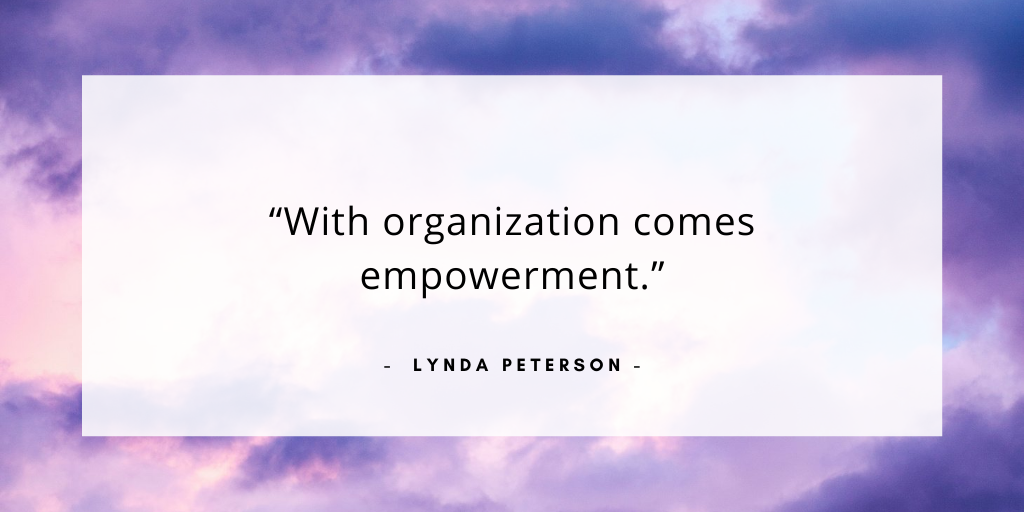All seasons are good seasons for getting organized.
Lining your ducks up in a row can dramatically improve your workflow, reduce stress, and boost your overall well-being. The fall semester, in particular, is a great time to refresh your environment. Beginning-of-the-year programs start to slow down a bit, and the trees symbolically shed their leaves in preparation for autumn. It’s a season of change, fresh starts, and renewed energy.
If the idea of an overhaul inspires you, don’t be so quick to start tossing old files into trash bags or take down the diplomas from your wall. Instead, heed this warning: Don’t bite off more than you can chew during your decor revamp.
You can stock up on stackable bins, multi-colored highlighters, and the latest organization manuals, like this one from the hosts of The Home Edit. But the real key to seeing an organization project through from start to finish is tackling it in manageable pieces. As a self-proclaimed neat freak, I’ll show you how.
Step 1: Make a list
Think about your organizational problem areas. Is it that storage closet in the back of the office? Or maybe that folder in your email inbox that’s collecting way too many unanswered messages? Or is it your work bag that mirrors the one Mary Poppins toted around?
Start compiling ideas of which projects you’d like to tackle. Be as specific as possible and break down the micro-tasks within each project area. Then, list those items in order of what requires your attention first. This will allow you to expend your newfound energy on prioritizing the most urgent tasks.

Step 2: Order supplies
You don’t want to start a project and then be stopped in your tracks when you realize you don’t have everything you need to execute it. That’s a quick way to lose momentum. So throw organizational essentials — like this drawer organizer, these labels, and a multi-faceted pegboard — into your shopping cart. Don’t start organizing until these essentials are in your hands.
Step 3: Find the time
Block off some time on your calendar when you can truly focus on organizing your space. Leaving the project unfinished, as you head off to another obligation, will mean you’ll eventually return to a disorganized mess, which isn’t exactly motivating or inspiring.
Step 4: Start with a blank slate
Let’s say you want to organize your office space. More specifically, you want to get your desk in order, clear out your filing cabinets, and reconfigure your bookshelves. Choose one to start on first.
Empty your chosen item’s contents. If it’s your desk, remove everything that’s on top of it and that’s stored in its drawers or cabinets. If it’s your filing system, move your folders and documents to a secure location. For your bookshelves, clear off books, frames, candy jars, and any other decorative trinkets.
Once you’ve wiped off the dust on your vacant shelves and desktop, you’ll be ready to tackle the next step.
Step 5: Toss what you don’t need
If you’re anything like me, you probably have an emotional attachment to things — that document you might need someday or that kind note a student left you a few years back. Take a deep breath and prepare to part ways.
If an item no longer serves a purpose, you don’t enjoy it anymore, or you haven’t used it in years, toss it. Doing so will allow you to make space for things that you do actually need at your fingertips.
And if the item does hold sentimental value or you think you might need to come back to it next semester, consider archiving it in another location — such as an office storage room or a cabinet located out of arm’s reach.
Step 6: Place things in categories
Place similar things near each other so there is no confusion on where you might find something. Categorizing all of your items will also help you visualize the most effective way to use your space.
For example, if you have years worth of receipts that your institution requires you to hang on to, then you might want to allocate a significant portion of your space to receipt storage. But, if you only have a small stack of evaluation forms for upcoming student meetings, you can stow those in a small tray on your desk instead of in a bulky binder.
Laying this all out beforehand will make the process of reorganizing your items much smoother.

Step 7: Have a run-through
Once you’ve placed all your items neatly into their new homes, conduct a test run. Are you able to navigate the space easily? Or are you still fumbling to figure out where you stored the paper clips or highlighters?
Rest assured that your new organizational system does not need to be set in stone. If you live with it for a week and realize that it doesn’t serve your needs, then you can (and should) revisit the project. And don’t move on to the next organization project until you feel completely comfortable with your first one.
Step 8: Revisit quarterly
Do you know how things get messy and unorganized in the first place? It happens when you let miscellaneous items accumulate over time or when you let your organization system slide.
It starts with one document placed in the wrong folder; suddenly, you’ll have a stack of contracts on your desk that you swear you’ll file away soon. But the life of a student affairs professional is chaotic; we all know that seemingly small tasks and habits are the first to be neglected when work gets busy.
So do yourself a favor and put a reminder on your calendar to recalibrate your space each semester or quarter. This will prevent your spaces from becoming unruly so that you can avoid revisiting step one all over again.
Organization is a daunting, continuous task. If it were easy, all of our workspaces would be meticulously maintained. But I hope that these steps will help you pare down the process so that tidying up will feel less intimidating. Perhaps you can even make organization a team-building activity that leaves each staff member feeling refreshed and ready to tackle whatever’s next.
What other organizational tips do you have? Connect with us on Twitter @themoderncampus.






